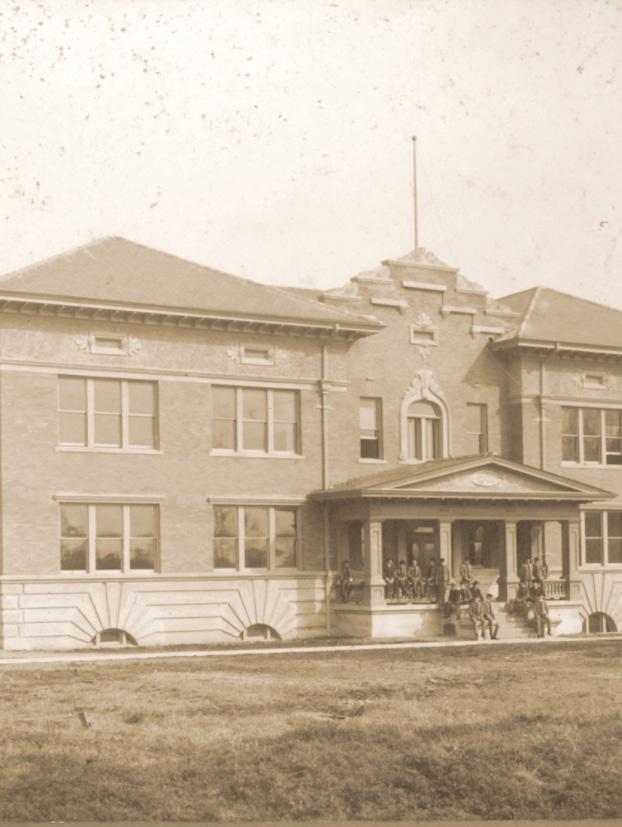
5 minute read
INTERESTING LSU FACTS & HISTORY
By Sarah Francioni
Welcome Freshman Class of 2024 to the beginning of a new and exciting chapter in your lives! There is a lot to look forward to as an incoming LSU Tiger. However, I’d like to take a moment and look back at a few interesting historical facts about Louisiana State University that you might not know.
Advertisement
ATHLETICS

•LSU’s Athletics Department fields 21 varsity sports, including 9 men’s teams and 12 women’s teams.
•LSU has won a total of 47 team National Championships.
•With a capacity of 92,400, Tiger Stadium is the seventh-largest oncampus stadium in the nation. When full, Death Valley contains more people than there are in 51 of Louisiana’s 64 parishes.
•It wasn’t until 1959 that Tiger Stadium was first called Death Valley after beating Clemson
•Previously known as Deaf Valley because of the crowd noise.
•LSU President David Boyd had originally chosen Blue and White to be the university colors. Just before LSU’s first football game against Tulane, Coach Charles Coates and quarterback Ruffin Pleasant decided to purchase streamers for the locker room. Mardi Gras season was approaching and all that the two could find were purple and gold streamers. From then on these two colors became the official colors of the university.

MIKE THE TIGER

•LSU raised $750 collecting 25 cents from each student and purchased a 200lb, one-year old tiger from the Little Rock Zoo.
•Originally named Sheik, his name was changed in honor of Mike Chambers, the man most responsible for bringing him to campus.
•Mike I was LSU’s first live mascot from 1936- 1956.
•Construction on the current habitat began in November of 2004 and was completed in 2005.
•Mike’s yard alone encompasses 14,010 square feet.
•Mike eats 20lbs of food daily, weekly consuming 140lbs of food.
•He is on a carnivore diet.
•Mike has a personal veterinarian, Dr. David Baker, who oversees his overall healthcare and wellness.
•Mike’s daily care is provided by two veterinary students.
•Tiger Conservation Fund: LSU has started a new fundraising campaign that will support students efforts to save the tigers in the wild. Visit lsufoundation.org/tigerconservation.

KLSU

•In 1915, LSU professors installed a wireless station, the beginnings of the radio station that would eventually be known as KLSU.
•This wireless station was made up of two eighty-foot towers atop the physics and chemistry buildings that were connected by four 300 ft wires.
•In 1917, plans for the evolution of LSU’s radio station were put on hold as a result of WWI and did not resume until 1918.
•The radio station undergoes several name changes from the birth of its existence to 1983 when it is officially changed to KLSU.
•In 1985, KLSU hosted a fundraising event “Juke in the Box” in which 3,000 people attended and bands play for over eleven hours.
REVEILLE

•The earliest known issue of the Reveille was published in 1887.
•The newspaper became a permanent part of campus on Jan. 14 1897.
•In 1934 The Daily Reveille earned national recognition after Sen. Huey P. Long had seven staff members expelled after publishing something he believed shouldn’t be in “his” newspaper.
•The Reveille Seven include: Carl McArn Corbin, Samual A. Montague, Stanley D. Shlosman, Cal Joseph Abraham, Jesse H. Cutrer Jr., L. Rea Godbold, and David R. McGuire Jr.
•The publication became The Daily Reveille in 1938, and was pushed back to semiweekly status during World War II.
•In 1947 it resumed Daily publication again but dropped down to just four days a week in 1951.

GUMBO

•The Gumbo yearbook began publication in 1900, chronicling news, sports, events, and highlights of the academic year.
•In 2015, Gumbo began a photo series titled “Humans of LSU” mimicking a photo blog titled “Humans of New York.”
•In the year 1918-1919, Gumbo was not published as a result of wartime pressures.
•In the 92-93 and 93-94 academic school years, Gumbo became a magazine of sorts, as funds would not allow for a hardcover publication.
MEMORIAL TOWER

•The Memorial Tower was one of the first structures built on campus. It was built in 1923 and dedicated in 1926 to those who gave their lives during WWI.
•The Memorial Tower is 175 ft tall and was built by Architect Theodore Link.
•The Plaza area in front of the Memorial Tower has served as a place of ceremony and celebration.
•Christmas Tree Lighting Ceremony
•Student Government holds its formal installation of its new President and Vice President.
•Valentine’s Day tradition: One must be kissed under the tower when the bells chime at midnight, which usually never chime after 10 pm except on Valentine’s Day.
•The inside of Memorial Tower is home to a military museum.
•At noon the University alma mater is played.

TIGER TV

•Student television began airing in 1988.
•Tiger TV is considered one of the most modern Student television stations in the country.
•Tiger TV’s Youtube Channel has over 11,000 subscribers.
•Tiger TV has an almost $1-million state of the art television studio.
•Tiger TV shares its equipment and facilities with the Manship School of Mass Communication.
LSU INDIAN MOUNDS
•The LSU Indian Mounds are some of the oldest in North America, Mesoamerica and South America.
•The Indian mounds are thought to have been built during the Archaic period around 5,000 years ago.
•They are 20 ft. tall. •They predate the Great Pyramids of Egypt, and are believed to be the oldest surviving man-made structure in the America’s.
•Scholars believe these mounds were “ceremonial and marking point” purposes, rather than burial grounds.
•In 2009, LSU Professor Brooks Ellwood, took core samples that revealed charcoal, possibly from a pit or cremated human remains.
•Ellwood concluded that the mounds do contain cremated human remains that are around 11,300 years old.
•In 1985, a sidewalk was built in between the mounds to avoid any further degradation or erosion in a heavily trafficked area of campus.
•The mounds were listed on the National Register of Historic Places on March 1, 1999.




